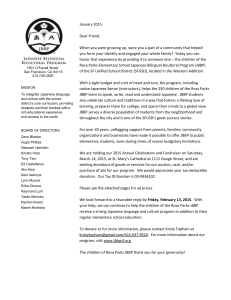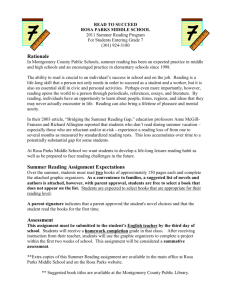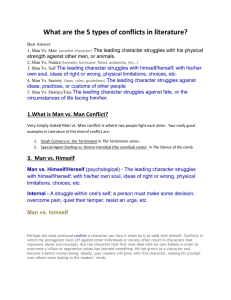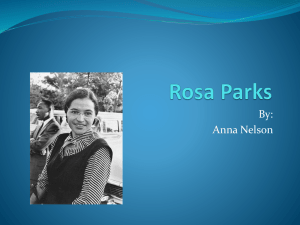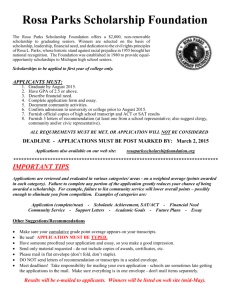Rosa Parks Comparing Texts Bio + Poem Close Reads
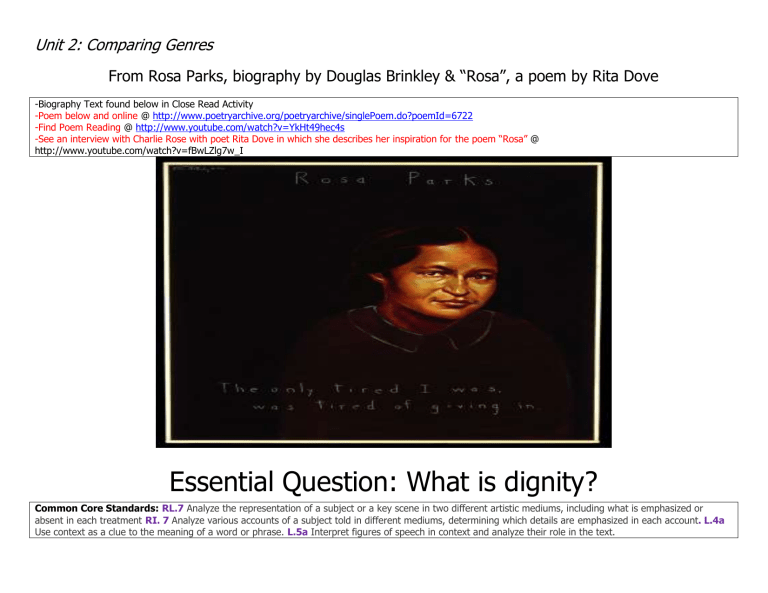
Unit 2: Comparing Genres
From Rosa Parks, biography by Douglas Brinkley & “Rosa”, a poem by Rita Dove
-Biography Text found below in Close Read Activity
-Poem below and online @ http://www.poetryarchive.org/poetryarchive/singlePoem.do?poemId=6722
-Find Poem Reading @ http://www.youtube.com/watch?v=YkHt49hec4s
-See an interview with Charlie Rose with poet Rita Dove in which she describes her inspiration for the poem “Rosa” @ http://www.youtube.com/watch?v=fBwLZlg7w_I
Essential Question: What is dignity?
Common Core Standards: RL.7 Analyze the representation of a subject or a key scene in two different artistic mediums, including what is emphasized or absent in each treatment RI. 7 Analyze various accounts of a subject told in different mediums, determining which details are emphasized in each account . L.4a
Use context as a clue to the meaning of a word or phrase. L.5a Interpret figures of speech in context and analyze their role in the text.
Introduction: Some people possess the silent power and aura of personal dignity. One person who refused to compromise her personal dignity made an immeasurable and eternal impact on American culture. This person was Rosa Parks. You will read and learn about Rosa Parks in two different mediums – a biography and a poem. Both pieces of literature will depict her dignity and bravery and the critical role she played in the civil rights movement.
Making the Connection: With a small group of classmates, discuss the essential question. Then, comprises a list of people that you consider to have dignity. These people may be living or dead, and can be real people, or characters you have read about in different literature or seen on TV or movies. Discuss what they did and said that demonstrated they were people or characters with dignity.
Analyzing the Text: Characterization in Different Genres
As you already know, fictions writers use techniques of characterization to create and develop their fictional characters. However, when writers of nonfiction and poetry portray real people, they cannot make up events, facts, or details. Instead, writers in these genres shape readers’ understandings of a particular people by uniting true information with methods specific to the genres in which they are writing. Both the biography and the poem are about Rosa Parks, but the authors use different techniques of
characterization as they write about her. See the graphic organizer below to see what genre techniques they utilized to characterize her.
Characterization Techniques Used in the Biography
Details and facts about Rosa Park’s actions, thoughts, and appearance
Quotes from Rosa Parks
Quotes from other people who knew Rosa Parks
Characterization Techniques used in the Poem
Specific word choice to describe Rosa Parks’ actions and appearance
Images to portray Rosa Parks’ traits
As you read, try to notice the techniques each writer utilizes to depict this historic and important figure. Also, focus on synthesizing the ideas expressed.
Strategies for Reading: Create a Reason for Reading
When you create a reason, or set a purpose, for reading, you choose specific reasons for reading a piece of literature. In this lesson, you will read a biography and a poem with the primary goal of comparing and contrasting the way the two authors depict Rosa Parks.
While reading, think about your impression of Rosa Parks based on how she is being portrayed to you in the two texts.
Vocabulary in Context: Which of the words do you already know? Write a sentence for each of the words and then check your understanding after you have read both texts.
1.
Frenetically
2.
Protégé
3.
Reverie
4.
Exhortation
5.
Serene
6.
Retrieve
About the Author
About the Author
Douglas Brinkley, author of biography “Rosa Parks”
Douglas Brinkley (born in 1961) is an American author, professor of history at Rice
University and a fellow at the James Baker Institute for Public Policy. Brinkley is the history commentator for CBS News and a contributing editor to the magazines Vanity Fair and
American Heritage. A public spokesperson on conservation issues, Brinkley serves as an editor at Audubon Magazine. He joined the faculty of Rice University as a professor of history in 2007. His biography Rosa Parks was published in 2000. In addition to numerous other published works, Brinkley and actor Johnny Depp were nominated for a Grammy for their co-authoring of the liner notes to the documentary: Gonzo: The Life and Work of Dr.
Hunter S. Thompson . He also co-edited with Johnny Depp the long lost novel of Woody
Guthrie titled House of Earth.
Austin, Texas.
He currently lives with his wife and their three children in
Rita Dove, author of the poem “Rosa”
Rita Frances Dove, born 1952, is an American poet and author. From 1993–1995 she served as Poet Laureate Consultant in Poetry to the Library of Congress. She was the first
African American to be appointed since the position was created by an act of Congress in
1986 out of the previous "consultant in poetry" position. Dove also received an appointment as "special consultant in poetry" for the Library of Congress's bicentennial year from 1999–2000. Dove is the second African American to receive the Pulitzer Prize for
Poetry, in 1987, and she served as the Poet Laureate of Virginia from 2004 to 2006. Her poem “Rosa” was published in 1999. She currently lives with her husband and their daughter in Charlottesville , Virginia.
Background information for the biography and poem
The American southern states once had laws that enforced racial segregation. Among other injustices, African Americans were forced to site in separate sections of public buses. In 1955, Rosa Park’s refusal to give up her seat on a bus sparked a 382-day bus boycott by African Americans in
Montgomery, Alabama. The boycott brought Rosa Parks and Dr. Martin Luther King, Jr., and their fight for civil rights into the national spotlight. In
1956, the Supreme Court ruled that segregation on buses and other public transportation was unconstitutional and hence, illegal. Rosa Parks' role in the Civil Rights was incalculable and she remains celebrated as a hero today.
From Rosa Parks, by David Brinkley
Rosa Parks headed to work on December 1, 1955, on the Cleveland Avenue bus to Court Square. It was a typical prewinter morning in the Alabama capital, chilly and raw, topcoat weather. Outside the
Montgomery Fair Department Store a Salvation Army Santa rang his bell for coins in front of window displays of toy trains and mannequins modeling reindeer sweaters. Every afternoon when school let out, hordes of children would invade the store to gawk at the giant Christmas tree draped with blinking lights, a mid-1950s electrical marvel. But Rosa Parks saw little of the holiday glitter down in the small tailor shop in the basement next to the huge steam presses, where the only hint of Yuletide cheer came from a sagging, water-stained banner reading
“Merry Christmas and a Happy New Year.”
Not that many of Montgomery Fair’s lower-level employees had the time to let the faded decoration make them sad. The department store rang up nearly half of its sales between Thanksgiving and New
Year’s Day, which turned the tailor shop into a beehive of activity every December. But even on days spent
frenetically hemming, ironing, and steam-pressing, Parks’ mind was more with the NAACP than her workday duties. She was in the midst of organizing a workshop to be held at Alabama State University on
December 3–4 and spent the morning during her coffee break telephoning H. Council Trenholm, president
Close Read
Analyze Visuals: What qualities of Rosa Parks does this image suggest?
Explain your answer using details from the photo.
frenetically-(adv.) in a frenzied or frantic way
NCAAPP- a civil rights organization.
The initials stand for National
Association for the Advancement of
of the university, applying enough quiet persuasion to be granted the use of a classroom over the weekend.
“I was also getting the notices in the mail for the election of officers of the senior branch of the NAACP, which would be [the] next week,” Parks recalled. That afternoon, she lunched with Fred Gray, the lawyer who defended Claudette Colvin and was serving as Clifford Durr’s protégé at his law office above the Sears Auto Tire Store.
“When 1:00 p.m. came and the lunch hour ended, Mrs. Parks went back to her work as a seamstress,”
Gray would write in his civil rights memoir, Bus Ride to Justice. “I continued my work and left the office in the early afternoon for an out-of-town engagement.”
Shortly after 5:00 p.m., Rosa Parks clocked out of work and walked the block to Court
Square to wait for her bus home. It had been a hard day, and her body ached, from her feet swollen from the constant standing to her shoulders throbbing from the strain and her chronic bursitis. But the bus stand was packed, so Parks, disinclined to jockey for a rush-hour seat, crossed Dexter Avenue to do a little shopping at Lee’s Cut-Rate Drug. She had decided to treat herself to a heating pad but found them too pricey. Instead, she bought some Christmas gifts, along with aspirin, toothpaste, and a few other sundries, and headed back to the bus stop wondering how her husband’s day had been at the Maxwell Air Force Base Barber Shop and thinking about what her mother would cook for dinner.
It was in this late-day reverie that Rosa Parks dropped her dime in the box and boarded the yellowolive city bus. She took an aisle seat in the racially neutral middle section, behind the movable sign which read “colored.” She was not expecting any problems, as there were several empty spaces at the whites-only front of the bus. A black man was sitting next to her on her right and staring out the window; across the aisle sat two black women deep in conversation. At the next two stops enough white passengers got on to nearly fill up the front section. At the third stop, in front of the Empire Theater, a famous shrine to country-music fans as the stage where the legendary Hank Williams got his start, the last front seats were taken, with one man left standing.
The bus driver twisted around and locked his eyes on Rosa Parks. Her heart almost stopped when she saw it was James F. Blake, the bully who had put her off his bus twelve years earlier. She didn’t know his name, but since that incident in 1943, she had never boarded a bus that Blake was driving. This day, however, she had absentmindedly stepped in. “Move y’all, I want those two seats,” the driver barked on behalf of Jim Crow, which dictated that all four blacks in that row of the middle section would have to surrender their seats to accommodate a single white man, as no “colored” could be allowed to
sit parallel with him. A stony silence fell over the bus as nobody moved. “Y’all better make it light on yourselves and let me have those seats,” Blake sputtered, more impatiently than before. Quietly and in
Colored People.
protégé (n)-. a person who is guided or supported by an older or more influential person
Claudette Colvin . . . Clifford
Durr’s: Claudette Colvin was an
African-American teenager who had refused to give up her seat on a
Montgomery city bus earlier in 1955.
Clifford Durr was a white lawyer who worked for civil rights
Characterization-
Reread the bolded paragraph. What do Rosa Parks’ thoughts and actions reveal about her character?
reverie (n.)- a state of daydreaming
racially neutral middle section: a section of the bus where African
Americans could sit, as long as no whites needed or wanted seats there
Jim Crow: a term referring to the segregation of African Americans
Common Core L.4a
Language Alert: Word Roots The
Latin root word commodare (“to
unison, the two black women sitting across from Parks rose and moved to the back. Her seatmate quickly followed suit, and she swung her legs to the side to let him out. Then Parks slid over to the window and gazed out at the Empire Theater marquee promoting A Man Alone, a new Western starring
Ray Milland.
The next ten seconds seemed like an eternity to Rosa Parks. As Blake made his way toward her, all she could think about were her forebears, who, Maya Angelou would put it, took the lash, the branding iron, and untold humiliations while only praying that their children would someday “flesh out” the dream of equality. But unlike the poet, it was not Africa in the days of the slave trade that Parks was thinking about; it was racist Alabama in the here and now. She shuddered with the memory of her grandfather back in
Pine Level keeping watch for the KKK every night with a loaded shotgun in his lap, echoing abolitionist
John Brown’s exhortation: “Talk! Talk! Talk! That didn’t free the slaves. . . . What is needed is action!
Action!” So when Parks looked up at Blake, his hard, thoughtless scowl filled her with pity. She felt fearless, bold, and serene. “Are you going to stand up?” the driver demanded. Rosa Parks looked straight at him and said: “No.” Flustered and not quite sure what to do, Blake retorted, “Well, I’m going to have you arrested.” And Parks, still sitting next to the window, replied softly, “You may do that.”
Her majestic use of “may” rather than “can” put Parks on the high ground, establishing her as a protester, not a victim. “When I made that decision,” Parks stated later, “I knew I had the strength of my ancestors with me,” and obviously their dignity as well. And her formal dignified “No,” uttered on a suppertime bus in the cradle of the Confederacy as darkness fell, ignited the collective “no” of black history in America, a defiance as liberating as John Brown’s on the gallows in Harpers Ferry. make fit”) has lent itself to the formation of many English words, such as commodious (“roomy”).
Reread the bolded lines. Which word in this sentence comes from commodare? What does the word mean?
Characterization: What do you learn about Rosa Parks from the way she reacted to the bus driver’s commands? Explain your answer.
back in Pine Level . . . KKK: Pine
Level is a town about 100 miles southeast of Birmingham. The KKK was the Ku Klux Klan, an extremist secret society that often violently terrorized blacks in the South.
exhortation (n)-. a communication strongly urging that something be done
serene (adj.)- calm; peaceful
abolitionist John Brown’s: Brown, a white militant, performed radical acts to force the abolition of slavery, including a failed attempt to steal guns from the U.S. arsenal at Harpers
Ferry, Virginia.
“Rosa”, by Rita Dove
How she sat there, the time right inside a place so wrong it was ready.
That trim name with it’s dream of a bench to rest on. Her sensible coat.
Doing nothing was the doing: the clean flame of her gaze carved by a camera flash.
How she stood up when they bent down to retrieve her purse. That courtesy.
Photo #1
Photo #2
“Rosa” a poem by Rita Dove
Close Read
Analyze Visuals: Compare the two photographs of Rosa
Parks. The second photo is taken when she was arrested.
What strikes you about these photographs? What can you infer about her by her appearance?
Common Core L.5a – Paradox
A paradox is a figure of speech in which a seemingly contradictory statement reveals some insight or truth. How is the thought expressed in the first line of the third stanza a paradox?
Retrieve (verb) – to find and return safely
Characterization: Which images depict Rosa Parks as a modest, humble person? Which depict her as strong and serious? Cite evidence and explain your answer.
After Reading Questions
Common Core Standards: RL.7 Analyze the representation of a subject or a key scene in two different artistic mediums, including what is emphasized or absent in each treatment RI. 7 Analyze various accounts of a subject told in different mediums, determining which details are emphasized in each account .
1.
(Recall DOK 1) – Where did Rosa Parks sit when she boarded the bus?
2.
(Recall DOK 1) – Why did the bus driver demand that she move her seat?
3.
(Summarize DOK 2) – What did Rosa Parks decide to do when she was asked to move?
4.
(Draw Conclusions DOK 3) Rosa Parks was an normal, everyday person, but she helped to spark the civil rights movement.
Why was she able to apply such a massive influence?
5.
(Analyze Characterization DOK 3) – Compare the biography and the poem. What words and actions communicate Rosa
Parks’ dignity?
6.
(Make an inference DOK 3) – At the end of the poem, the poet calls someone “courteous.” Who is she calling “courteous” and do you think her use of this word was meant to be genuine or ironic? Explain your answer.
7.
(Compare Genres DOK 4) – After reading both texts, consider the similarities and differences in the details used to portray
Rosa Parks. Create a Points of Analysis graphic organizer like the example below, and answer the questions. If a point is not application in one of the texts, leave the corresponding box blank.
Points of Analysis
What do you learn about Rosa Parks’ appearance?
What do you learn about her daily life?
In the Biography In the Poem
What do you learn about her character through her thoughts and feelings?
What do you learn about her values and the things she considers important?
What genre techniques did the author utilize to portray Rosa Parks?
8.
(Enduring Understanding) – Reread the essential question and the person you decided was a person with dignity. What qualities does the person share (if any) with Rosa Parks? Now that you have read the biography and the poem, what qualities do you think a person must have to be considered a person with dignity?

